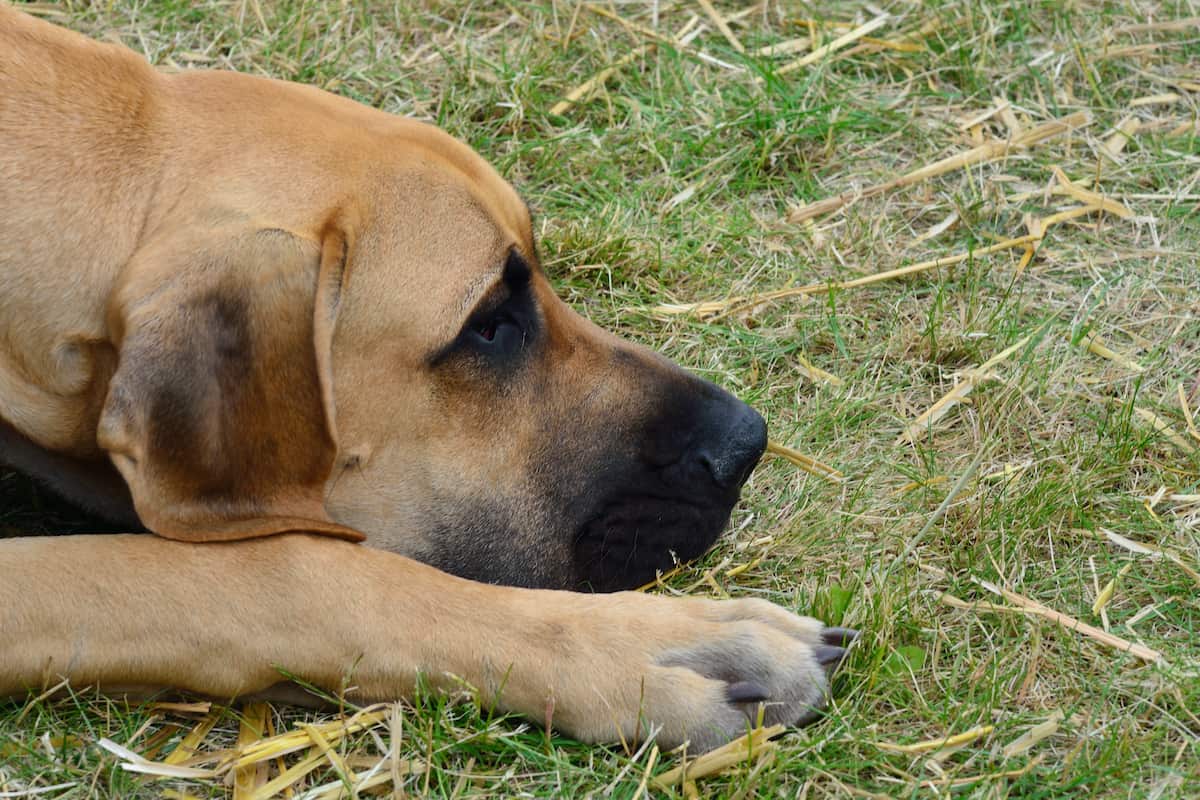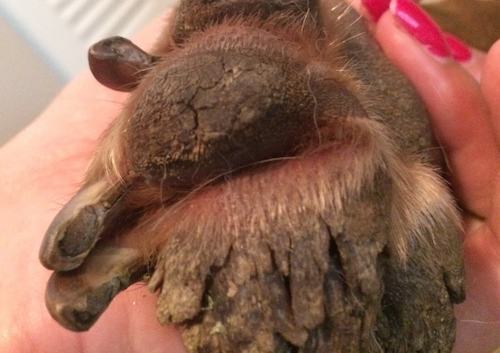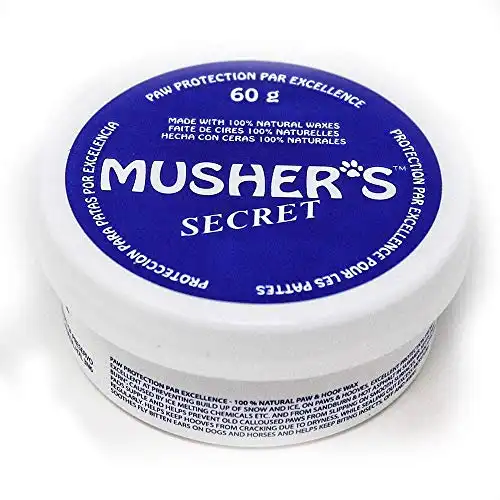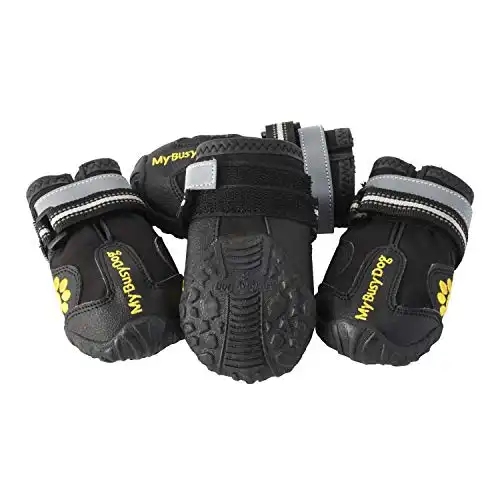
Have you noticed that your Great Dane has very rough paw pads and wondered if it’s normal? Dogs spend a lot of time on their paws, so it’s fair to think that they need to be tough, but is it something that you should be concerned about?
Why does my Great Dane have rough paw pads? The medical term for rough paw pads is called paw pad hyperkeratosis. While there a number of remedies for treating rough paw pads, there are also a wide variety of reasons that they form including:
- Infection
- Symmetrical Lupoid Onychodystrophy
- Acral Lick Granuloma
- Zinc Deficiency
- Pemphigus Foliaceous
- Genetic Hyperkeratosis
- Distemper
- Leishmania
- Playing on Hard Surfaces
Many of these conditions can be easily treated or even managed at home so that your Great Dane has soft paw pads again. Some of these will require extensive treatment to get your Great Dane’s paws soft again.
What is Paw Pad Hyperkeratosis?

Paw pad hyperkeratosis is the medical term for thickening paw pads.
Their paw pads are usually dry, crusty and can easily crack. Many of these paw pads will look like they have weird hair-like growth on the bottom of their paw pads.
This is the flaky layers of your Great Dane’s paw pads.
What Causes Paw Pad Hyperkeratosis?
Hyperkeratosis is a condition that causes your Great Dane’s body to make too much keratin.
This is usually a genetic problem that starts during the first year of your dog’s life and can more often be due to a more serious medical problem.
If you notice rough paws on your Great Dane, it is best to have your vet examine your dog to make sure that there is nothing wrong with them.
These are the most common causes of Hyperkeratosis in Great Danes.
- Bacteria or fungus infections – An infection of your Great Dane’s paw pad will cause it to become thick and rough. An infection is usually secondary to some other underlying disease such as hypothyroidism, Cushing’s, an allergic reaction, or autoimmune disease and cancer
- Symmetrical lupoid onychodystrophy: This is an immune-mediated disorder that can affect your Great Dane’s paw pads and nails
- Acral lick granuloma – This is caused by your Great Dane constantly licking their paw pads. This is believed due to many causes such as emotional or environmental stress, boredom, separation anxiety, confinement, or loneliness. This can also be caused by a medical problem such as parasites, trauma, foreign bodies, or hypersensitivity to food and their environment.
- Zinc deficiency Hyperkeratosis– This is caused by not enough zinc in your Great Dane’s diet, or they cannot properly absorb zinc in their intestines. This causes crusting, scaling, redness, and eventually lead to hyperkeratosis of the footpads. This can usually be treated with daily zinc supplements
- Pemphigus foliaceous – This is the most common autoimmune condition seen in dogs. It is usually idiopathic, which means that there is no real known cause. It often causes scab like a blister and can also cause your Great Dane to have rough paw pads. This is diagnosed with a biopsy of the paw pads. It can be treated with certain immunosuppressive drugs and can affect any breed, gender, or the age of your Great Dane.
- Genetic Hyperkeratosis – In this condition, your Great Dane’s footpads will be thickened, hard, and cracked. Their feet are usually normal when they are born, but by 5 or 6 months of age will have hard paw pads. This is usually genetic, and there is no real cure but can be managed with frequent treatments. There are a few breeds that are predisposed to this, such as Golden Retrievers, Labs, Dogues de Bordeaux, Bedlington Terries, and Irish Terrier. Luckily this is not a common genetic condition seen in a Great Danes.
- Canine distemper – This is a very rare problem seen nowadays as there is a vaccine that can help prevent this disease. Distemper can cause many problems if your Great Dane gets this virus. This virus is very serious, and usually, only about half of the dogs who get this virus survive.
- Leishmaniasis: This disease is not very common in the US. Sandflies or other parasites usually spread it. This can affect your Great Dane’s make your Great Dane have rough paw pads as well as affect their skin, abdominal organs, and fur.
- Playing on Hard Surfaces: If your Great Dane is constantly running and playing on hard surfaces such as concrete or rocks, they will have rough paw pads. Their paw pads are meant to protect their feet from the ground and act as shock absorbers when they are running around. Most people have shoes that protect the bottom of their feet and keep them soft.
Symptoms of Rough Foot Pads in Your Great Danes
There are many situations and health problems that can cause your Great Danes paw pads to be ruff.
Most of the time, you can see and feel the rough pad, but these are some other signs that you may see in your Great Dane that would indicate that you need to take a look at their pads.
- Thick and hard skin on footpad and around the nose
- Splitting or cracking of the skin in the paw area, these may even ooze pus or blood
- Crusty
- Hair Loss
- Pain walking or running around
- Itching
- Constant licking paws
- Changes in the growth of the nails
- Changes in the way they walk because it is too painful walking.
- Abnormal nail growth
- Swollen paw
- Lesion developed on the paw pads
While these can be a sign of rough pads in your Great Dane, they could also be the start to something worse.
Your vet can examine your Great Dane to make sure that there is not an underlying problem.
Diagnosis of Thick Foot Pads in Your Great Dane
Since there are many reasons that your Great Dane could have a rough paw pad, there are many ways to diagnosis what is causing this problem. Your vet will examine your pet, ask you about what they are eating, their exercise habits, and your lifestyle.
It is best to also mention to your vet the type of surface that your dog is constantly walking on.
After your vet examines your Great Dane, they may want to run a blood test, urine, or fecal testing. If they think it is an infection, they may want to take a skin sample or other culture.
Depending on what they find with those tests, they may want to also take x-rays. If your Great Dane is young, they may consider genetic testing.
Treatments for Rough Paw Pads in Your Great Dane
If there are any underlying problems that have caused your Great Dane’s paw pads to be rough, then that will need to be treated.
Many times, treatment will require many steps to take place over several weeks or even months. Sometimes the cause is never figured out, and a more manageable approach will be taken.
These are some common treatments that your vet may do to help treat your Great Danes rough paw pads.
- Adding a nutritional supplement, especially if your Great Danes has a nutritional deficiency
- Applying creams, ointments, or lotions to help soften the hard footpad.
- Sometime a rough paw pad may need occasional cutting or trimming away of the rough hard keratin on the paws of your Great Dane
- Depending on the underlying condition you may have to give your Great Dane medication such as thyroid pills, antibiotics or antifungals
- Improve the quality of your Great Dane’s diet
Dog Paw Balm
Musher's secret forms a breathable dense barrier to protect your dog's paws from the elements in even the most extreme weather conditions.
- Food-grade waxes
- Moisturizing pure blend
- Non-toxic formula
- Non-GMO & gluten-free
Dog Paw Balm is great for cracked and rough paw pads.
This is just like Chapstick and can be applied to your Great Dane’s paws every couple days!
Dog Booties
Our boots are here to help keep those paws protected for every adventure. Let’s face it our pups are our family and we want them to join in on the fun and be safe while doing it.
Your dog can wear shoes to help protect their feet. Most dogs can quickly learn to wear shoes and even socks.
These will protect the bottoms of their feet from everything in their environment. They even help keep their feet warm in the cold months.
For many, your Great Dane will need their paw pads treated on and off for the rest of their life. Many times, there is no underlying condition.
Applying Balms and creams to the bottom of their feet will help keep them soft. Also, when letting your dog outside to play, especially on rough surfaces, put dog booties on their feet.
These are designs to help not only protect their feet but keep them soft.
Prognosis of Great Danes with Rough Paw Pads
Your Great Dane can usually live a long and happy life with their rough paw pads.
Many will need weekly, if not daily, treatment to keep their paw pads healthy.
Final Thoughts on Rough Paw Pads
You may have noticed Great Dane has rough paw pads. These paw pads may require daily treatment to keep them soft.
Your vet can help you determine what is causing these paw pads from being so rough and make sure that there is not an underlying condition.
Applying paw balm and putting shoes on your dog will help protect their feet and keep them soft.



I make my own balm for dry hands and feet, so I use the same recipe for our great Dane Zeus, just without essential oils. Bees wax and coconut oil.
Cheers Jen
Does the balm stain the carpet/floors?